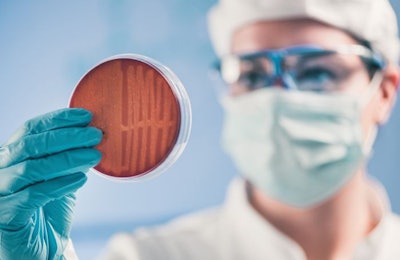
Campylobacter may be more important to broiler health than originally thought, as it is usually of greatest concern due to its threat to human health. Campylobacter's negative impact on commercial poultry was reviewed in several presentations at the XVth European Poultry Conference, held in Croatia in September.
Some strains of Campylobacter in commercial chickens may pose a real health and performance risk to flocks, and identifying the “more chicken pathogenic” strains and the mechanisms by which they affect birds is an important prerequisite for effective control, said Tom Humphrey, professor of bacteriology and food safety and head of the of the microbiology and infectious disease group at Swansea University Medical School in the U.K.
Despite Campylobacter usually being described as commensal, Humphrey highlighted that there is strong evidence from more than 30 years showing that Campylobacter can have a negative impact on broiler gut health.
He pointed to studies from the early 1980s in which broilers were given Campylobacter jejuni. Data showed that approximately 90 percent of infected birds had diarrhea, while mortality reached around 40 percent. The final body weight of infected birds was around 30 percent lower than that of the control birds.
More recent work in the U.K. has supported these earlier findings, but also shows that different Campylobacter strains differ in their impact on chickens. This, Humphrey noted, can create difficulties when comparing studies, and is further complicated by different chicken types showing different innate immune responses to C. jejuni.
This field work also found a significant relationship between broiler health and welfare and Campylobacter infection in commercial flocks; however, these studies were unable to determine whether Campylobacter benefited from poor broiler gut health, of whether the bacteria caused it.
Slow- and fast-growing bird divergence
C. jejuni has been found to affect fast- and slow-growing breeds differently.
Studies comparing C. jejuni in fast- and slow-growing chickens have found that fast-growing chickens had severe diarrhea, whereas slow-growing birds did not. With fast-growing birds, there was much damage to the gut mucosa, particularly in the ileum, while in slow-growing birds, with normal feces, the villi were found to be less affected.
Preliminary analyses of innate responses showed that gut damage in fast-growing broilers was associated with dysregulation of pro-inflammatory cytokines.
However, work by another group, using fast-growing birds with a different strain of C. jejuni, found similar damage to the ileal mucosa, but did not report diarrhea. Other studies have also found damage to the gut mucosa, but not all.
A variety of impacts have been found resulting from infection with C. jejuni. For example, some studies have found that infection in young birds with C. jejuni was lethal, and this has also been found in turkey and ostrich chicks.
Damage to the gut mucosa and diarrhea will not only affect nutrition, but the former will also contribute to the spread of Campylobacter to edible tissue, and there is long-standing and mounting evidence that the major health threat from Campylobacter-positive chickens is not from surface contamination -- edible tissue are also positive, almost exclusively with C. jejuni.
Contamination of chicken muscle is a public health threat that seems to be increasing, yet this is not fully understood.
Impact on gut health
Claudia Hess, of the Clinic for Poultry and Fish Medicine at the University of Veterinary Medicine (Vetmeduni) in Austria, looked at work carried out by Vetmeduni in collaboration with other universities that examined the interaction by C. jejuni with the gut barrier in broiler chickens.
Hess said this project has also found that Campylobacter is not an entirely commensal bacteria and that it can be seen as an important contributor to impaired chicken gut health, with experimental C. jejuni infection having severe consequences for gut health.
While the ceca is the part of the gut where Campylobacter tends to accumulate, it can also influence certain functions within the small intestine and, echoing Humphrey, she noted that it can disseminate to various internal organs, such as the liver and spleen, raising questions as to whether processing plant approaches to protect public health are sufficient.
The study demonstrated that C. jejuni can cross the intestinal epithelial barrier and facilitate the translocation of not only of Campylobacter itself, but also of other bacteria to extra-intestinal organs.
Changes to the intestinal barrier function led to increased intestinal permeability, the down regulation of certain nutrient transporters and an impact on mucus production, together influencing nutrient intake. Consequently, it was found that glucose uptake and amino acid availability were reduced after C. jejuni infection.
The study also found that C. jejuni infection can alter the gut microbiota. The level of Clostridium spp was found to be higher in infected birds than in control groups, demonstrating that C. jejuni was associated with significant changes in the composition of the intestinal ecosystem.
Hess also made reference to a study by Professor Marian Dawkins in the U.K. that compared the movements of flocks infected with C. jejuni against those of a negative flock. Movements in the infected flock corresponded more with those of sick flocks than those of health flocks.
How UK poultry companies are controlling Campylobacter


















